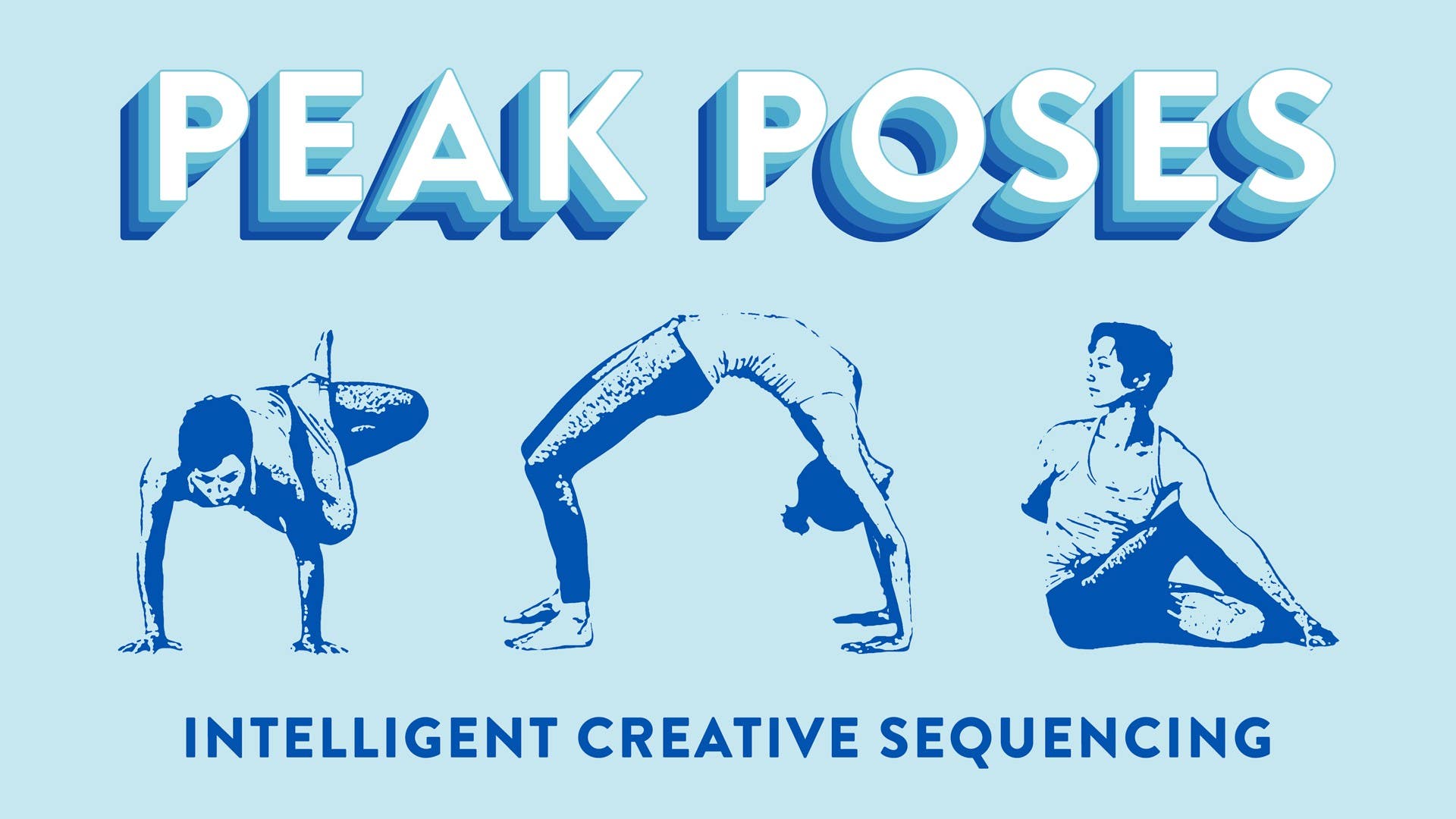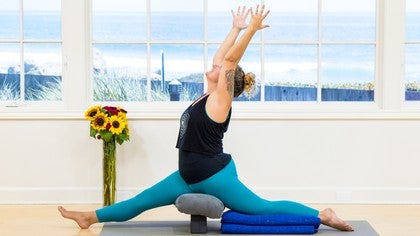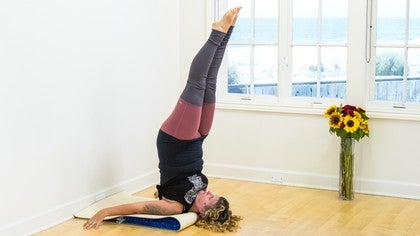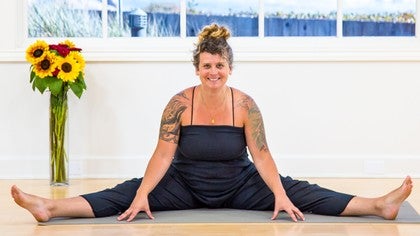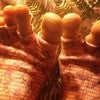Description
About This Video
Transcript
Read Full Transcript
Hi, today we're going to practice Upavishta Konasana, and I call this sequence our Nervous System Love Sequence. So we're going to actually start in Upavishta. You're going to grab a blanket, you can have it folded up long ways, and place it underneath your seat. If when you get into the pose, you can't get a natural curve in your lower back, you're going to want to prop yourself up higher and place blankets underneath the knees for support. Don't be afraid to use a lot of props, right?
Double blankets, bolsters, et cetera. So we're starting with a shallow variation. I'm not taking my feet as wide as I possibly can. And this is just our first check-in of the shape. And I want you to take notice of where your sitting bones are hitting the ground.
So drawing your felt sense into your body is one sitting bone heavier than the other, is one farther forward or farther back. And these aren't bad things, there's not something wrong, right? We're just taking note of kind of how our pelvis is orientated when we start the practice, and how it may or may not change as we go through it together. So from your shallow version of Upavishta, you'll take a twist, a really gentle one, just sweet, right? Over to the left, so your right hand comes in the center, the left hand comes behind.
You're moving your heart along the inner line of your left leg, and the gaze can stay there as well. Take a full inhale and a long exhale, right? I have some energy in my legs, but they're not fully flexed either. But they're not fully relaxed. My navel's drawing in, and I'm lengthening out through my spine.
All of those things I invite you to take part in. Come through center, and you pause, and again, checking in with the sitting bones, did it change? Is it the same? When I practice this, I actually take notes of how it changes, and then we'll twist on over to our right side. So left fingertips come in front, right hand comes behind.
So the sequence is inspired by my teacher Todd Jackson, and I found a lot of benefit in my body and my nervous system, emotional body from practicing in this way. Come back through center, and again, just checking in one more time, noting that starting point. So drawing your body into the pelvis, and then down into the earth. What side is weighted? What side isn't?
And then we'll take our hands and give a little assist and draw the knees back in together, and then we're going to come on down onto our back. So you'll need your blanket and your bolster, and so the way that you're going to set this up is so that the blanket on the nice edge is right here, and I'm going to use two because I know that I need that extra support for my neck. So I invite you to do that as well. If you only have one, one is fine. So they're nice and lifted, and then my bolster is going to go on top.
So I have a little bit of a ridge. So this is where my shoulder blades will go. This is where the top edge of my shoulder blades is for my head. This is where my back. And I'll come on down here, and I want to make sure that I'm far enough down so that the shoulder blades are moving towards this blanket, and my arms come out towards the side, and my head reaches back, and I'm going to bend into my knees here and breathe into my chest.
And so this is a back bend a little bit more into the belly than we might normally do. And if it's too intense here with the bolster, you can always just do blankets, right? One blanket folded long, and then the other one folded more in the square shape. I'm going to take a few more breaths here. So the idea is that I'm letting this open a little bit.
And so I'm grounding through my seat into the floor, and then I'm also grounding through the tops of my shoulder blades, letting this whole line of my belly open up. And so I'm still active here even though I'm on the ground. And then maybe the last breath I extend my legs out. I'm taking a few breaths here. Notice where there's any sticky spots.
Mine tend to be right at the top, my pectoral muscles. Can you allow those to unfold towards the ground? And then we'll start to rebend into the knees if you extended your legs. Take your hands behind your head, lifting the head up with the strength in your arms. Then bringing your hands down, pushing the elbows hands into the ground, sitting on up.
And we're going to move our props out of the way. And we'll come back down onto our back here. Getting the knees in towards the chest, and then letting the knees go a little bit wide. So this is a Supta Baddha-Kadhasana variation, and I'm wanting to kind of test out where I can take the width of my knees, and keeping my femurs relatively into their home base position in my hip socket. And when I find that depth, pausing, breathing here, right?
So we're not having to draw the feet in close, but more thinking about taking the knees wide than feet in close. Take a few more breaths. And then we'll draw the knees back in, plant both feet onto the ground here. And we'll take the left knee in towards the chest, and take the ankle towards the knee, your right knee. And so this might be enough, and you can totally stay here.
This is great, rocking side to side. If you've got a little bit more space, I want you to use the strength of your right knee and pull the foot closer in towards the body. Breathe here. And then, interleasing the fingers behind the thigh, even if you can take the shin, taking the thigh, breathing here, releasing through the hip. Under full breath, inhaling and exhaling.
And so from here, we'll slowly take a twist on over to the side. So you're going to keep this leg in the same position, and slowly take it all the way over, and you'll breathe here. So you can hold onto the foot, or you can let it go. The both shoulders are on the ground. This is our infinity twist, stage one, right, breathing.
And you get this stretch through the outer hip, and it can feel really yummy. Gaze can come off to the side, you might close your eyes. And slowly coming back through center, and take your knees back into your wide-kneed baddha kanasana, and again finding that position where the tops of your fingers still feel like they're in the pelvis. And then we'll draw knees back together, plant the feet on the floor, take your right ankle to your left knee, pause here, check in, how is this for you on this side, what are the differences between the two sides. And then with the strength of your left leg, taking that in towards the chest, interleasing the fingers behind the thigh if you can get there, and breathing here.
And so I often notice a lot of stretch sensation in my outer glute, and I'm trying to send some invitations to that area to see if it can soften. Everyone doesn't want to, but I still ask, and it's like the toddler, can you clean your clothes up, no, but we still ask. So from here we'll come over to that first variation of the infinity twist, you release the back of your thigh, and you can kind of help your foot come on over with your left hand, and I move my props a little bit until you can find the floor. And then release on down, both shoulders are on the ground still, the arm can come out to the side, and I automatically here realize, oh yeah, this side's a little bit tighter than the other one. You can hold on to that foot or you can let go of it, and we breathe here, this gets a nice long stretch around the glutes.
Sometimes a little bit different than that fore shape. You slowly release here, and we come back, knees in, femurs in their homes, finding that very variation, and then I'll extend my legs out onto my mat, and reach my arm up over to the overhead. So I'm coming over onto my right side body, I'm going to walk my fingertips a little bit farther out, and then I'm going to take my right hand behind my head, so you can find the ridge of your skull and kind of give just this really gentle assist upward, and it's so yummy, right, to kind of get this traction along your spine. And so we'll take a slow anantasana, and so even if you can straighten your leg right away, I'm going to invite you to do this slowly on purpose. So we're still grounding through our right leg, we'll take our left piece fingers around the toes.
If you can't get your toes, feel free to grab a strap and use that, and we're starting with a bent knee, and we take about three to four breaths here, with a fully flexed knee, and pressing the pelvis forward, opening the knee out to the side, and breathing in, and breathing out. And then we unfold, so this will go in about four parts, so we unfold one more step, and we stay here for about three breaths, and you'll start to notice that as you're here longer, it's got some more information to share, right, and that actually there's a lot of stuff in the transition that we miss when we go straight to straightening the leg. And then three, it's kind of almost straight, we breathe here. And then four, if you've got the straight leg, we breathe there. And then you're going to use your hand and help guide the foot all the way back down towards the ground, and it steps kind of in front of the thigh.
And then I'll use my hands and press myself up. So take your right hand, and it's a little bit of a diagonal, you know, out and away, and you just shrug your shoulder up towards your ear. It's totally like illegal yoga, and it's really nice to get this nice long stretch through the side body. We'll walk our fingertips on over towards the foot. It might be fingertips here.
It might be coming down onto forearms. And again, we're getting really deep into that outside of the hip. You can let the gaze come down. You can even release the head. Breathing here.
This is like a little baby dragon prep, which is a fun little funky arm balance. Press ourselves back on up, take that right arm out to the side. And now step your left foot behind you, press down into the ground, lift the whole thing up and over for a little up, up and away. Lowering the seat back down. And then coming down onto your back.
Breathing here, knees together, inhale, exhale. And then we'll come on over to our other side. So you'll take your left arm up and over. And then the left hand comes behind the head, and again, you give that sweet little assist. And then we straighten our legs on out.
Piece fingers around the big toe. And pausing here, taking a few breaths with a fully flexed knee. Finding an inhale and an exhale. And then unfolding, stage two, keep working that bottom leg, pressing the hips forward. The idea of this sequence is really to start to get into some of that deep held tension within our pelvis.
And as we release it, our nervous system thinks us and lets all this relaxation happen. One more step, kind of almost straight. Another breath here, noticing where the top of your thigh meets your pelvis, what places of tension are held here. And then what happens when we straighten all the way and come on up. And then we'll help guide the foot to come in front of the thigh here.
You lift yourself up onto your fingerprints. Your left hand's out towards the side, and then we shrug the shoulder up. I'm going to get this nice long stretch to the side body. Doesn't look like much, but it feels really good. And walking the fingertips closer in towards your foot, you might stay on fingertips or you might come down onto your forearms.
Releasing the head. Pressing yourself back up onto your hands. Left hand comes out to the side in a way. Take your foot, step it behind, and then inhale, lift the whole thing up and around. Up up and away, or wild thing.
Lowering it all the way back down, and coming back down one more time onto your back. Breathing here, inhale, exhale, letting yourself come on over to your side body. Press yourself all the way on up, and we'll come into our second Upavishta. So again, I'm going to grab one blanket and place this underneath my seat. You might decide to grab more than that.
So this time I'm coming a little bit wider with my legs, more towards my version of a fuller expression, and I'm checking in. Where are my pelvis, my sitting bones here? What side am I leaned over towards? Which one is farther forward? Which one is drawn up?
And they're different for all of us, and there's not necessarily a right or wrong answer. For most people they're not going to be perfectly symmetrical. Take a few breaths here, and then this time we'll start our twist over towards the right. Breathing here, inhale and exhale, again it's not a super deep twist. Come back through center, pause here.
And then on over towards the other side. And then back through center one more time. So here you want to look at your knee caps, and some of us are knee caps going to be straight up, some of us are tilted a little bit in, some are tilted a little bit out. So again, not a right or wrong answer, it's just to note how are your bones plugged in? What is your natural habit?
My natural habit is to have mine point out. Not one is better than the other. So I'm working to see if I can get my knee caps to point up. And what happens is that I have to not only release in the back side of my glutes, but I also have to engage through my inner legs in order for that to happen. So that totally changes the shape.
So from this place of even knees, or knees straight up, this is where we're going to come into our very first fold, right? And it's not going to be very deep, but you're trying to maintain that even knee, right? And just notice what happens as you start to come in. Just a few inches, maybe half inches, millimeters, trying to keep that nice long neutral spine. If this has a lot of sensation for you, even just upright, you're staying upright then.
And you take a few inhales and exhales here, consciously working those where the location of our knees are, keeping that in mind as we start to come a little bit more forward. Another breath or two here. Simply start to lift ourselves up. Give yourself some help. Take the hands underneath the knees here, draw your feet back together, and then just give a little squeeze, bringing the knees together, rounding through the spine.
And then we're going to come back down onto the ground and we're going to use a few more props. So I'm going to have my blankets set up like so towards the bottom, sort of two thirds of the mat. And then I'm going to have my bolster back here. And so what I'm wanting is the heart to be on the bolster, the head to be on the mat, and it's like the very tip of the tailbone to land on the edge of the blanket, and then my knees to be supported here on the blanket. And then I'll come on down, and I might have to adjust because I might not have measured myself quite perfectly, and so feeling free to do that.
So the blankets are supporting my knees when they come out to the sides, and then my arms wrap around the bolster to kind of come up and over like two arms around my buddies here and releasing for a Supta Baddha Konasana. Again what I'm looking for is that opening through this line of the belly. So my sacrum's kind of grounding and my shoulder blades are grounding. And so even though that I'm in sort of a restorative shape, I'm still active here. My body hasn't fallen asleep.
I'm not allowing it to necessarily be completely supported here. I'm consciously working that opening of the belly and then relaxing the thighs out. So it's very subtle shifts, but really slowly, right, my pelvis is tilting farther forward. Take a few more breaths here. Full inhale, long exhale.
Okay, I'll rebend into the knees, plant the feet on the floor. I'm going to use my hands to help me lift my head up. And then press all the way up. So I'll move my props out one more time, but I'm going to grab my blocks. So they're there, and then I'm going to come back down onto my back.
From here, I'm going to cross my right leg over my left and take a hold of my ankles here and coming to a lifted up Gomukhasana. So if you can't get your feet, ankles, shins, right, even just being here and holding one leg, that's fine too. But if you can get both, I kind of have to lift up and then I can grab both. Then I get this nice opening here, and I'm drawing my bottom knee in, really seen here. So this is our infinity twist number two.
So it's a little bit more intense than the first one. You're going to hang on to your foot, and you're going to let yourself roll over to that left side and ground the foot and the knee at the same time, and come back onto your shoulders. So while maintaining the contact of both feet, and this is a much bigger glute opener, right? You can really feel it in the side. If you can't hold onto the feet, that's fine too, and you can always go back to the first variation that we did here, but again, this is a little bit more intense.
If you want more out of it, taking the bottom leg and moving from the top of the quad all the way down through the knee, and you just get a little bit more, you might be able to ground the foot then. Shoulder blades are both on the ground. I'm going to release this on out, uncross the legs. Take my block one on low setting here, and draw my hips onto the block. Shoulders are down, and I'm doing that same action of tilting my pelvis forward, pressing the sitting bone into the block, and my shoulder blades into the ground.
So again, I'm still active here, even though it's supportive. Inhale, exhale. We'll slowly press down into the feet, lift the block out from underneath your seat, set it off to the side, and then we're going to come into the other side. So let's see, we'll take our left on top of the right, and draw the feet in. I have to sit up to get it, and this is the sweet side.
So just noticing, which side has a little bit more freedom, which side is a little bit more communicative, has more to say, and that's definitely true here. You can use your bottom knee to pull it in closer. The closer it is to your body, the more intense it is. And then we're slowly shifting the whole operation over to the side, being really slow to do it, and moving the knee down as the foot comes down, and then moving back onto your back. So this side, again, is my much more expressive side, and has a little bit harder time grounding my foot, so that's okay.
If you're wanting more out of it, you use the strength of that bottom leg moving all the way out of the pelvis through the knee, and sometimes you can get a little bit more grounding. You can also use straps here, you've got dual straps, put it around your feet, and hold on to that. Breathing here a couple more breaths, and again, noticing where there's tension, sending those invitations to the body to release. And then we slowly shift on out, uncross the legs, so you can always go back to that one black bridge pose, otherwise you might want to try two blocks underneath the seat. I've got to get up onto my tippy toes to make that happen, but then once I'm there, it's pretty nice.
So I'm finding my inner thighs, there's still a bit of a divot in the front of my pelvis. I'm finding my inner thighs, I'm pressing my seat into the blocks, and my shoulders into the ground, and my hands can release down. Closing off the space between my chin and my chest, and getting a little bit more of this opening through the belly. And as I do that, I might be able to take my hands a little bit farther down. Just noticing my tendencies to lift that up, and I'm trying to move in the opposite direction, and at least for me that's not super intuitive, so I have to really think about using those inner thighs and releasing the belly that's wanting to be held together.
And then we'll slowly press down, lift your heels if you need to, take the blocks out of the way, come on over to your side body, and then press yourself up for our third Upavishta. So again, I'm still going to use my one blanket for support, underneath my seat. You're wanting to sit like on the edge of the blanket, not fully on top of it, but more towards the edge so you're falling off of it a little bit, and then we're coming into our wider shape. So again, we're checking in, knees even, sacrum even, breathing here. And then I use my hand to help me, I'm going to bend into my right knee, so taking your right knee into a bend, bringing the heel towards the center of the pelvis, and then twisting over to your right.
And so notice how when you twist to the right, you can keep that left hip grounded, but what I'm wanting you to learn how to do is lift it up. So just notice what it feels like to really have one sitting bone on the ground and the other one not, right, when we're in the twist. And then you're going to take a fold on over that bent knee, and come on down all the way, releasing the neck. Another inhale, exhale here. We'll slowly start to press ourselves up.
So you're still facing your bent knee, and you're noticing potentially that your chest is more or less the line of your inner thigh, and if it's not, you want to kind of move in the direction so that it is. So you're still in a twist, right? And then slowly we'll start to side bend over. So from the twist, slowly starting to side bend over to the left. I'm going to keep my right hand towards my hip, and I'll put actually the full palm on there, and I'm going to give this encouragement to the hip to lift up.
So now I'm shifting the weight over into my left hip, the other one, right? And then from here, I'm going to take peace fingers around my toe. And then another assist, taking your right hand to your thigh and sending that energy that way, and my hip lifts up even more so. So this might be enough, and you can stay here, right? Otherwise we're taking the arm overhead.
And I'm working this action, reaching, reaching, reaching, reaching, reaching. And so it's not about touching the toes, which I can do, right? It's about going beyond the toes. The foot beyond the foot, beyond the foot, beyond the foot, right? Why limit yourself just to one?
And then from here, we'll open out, so you'll take your left elbow into the thigh, press the hand onto the ground, take your arm into diagonal, towards the ceiling, and spin and open the heart. And then gaze comes down, fingertips come down, press into the floor, lift up, assist yourself to re-extend the leg, and come back into your upavishta. Under your knees, notice your sitting bones, right? What's changed? What's the same?
And for me, what I notice is that I get more freedom in that lower back. I'm able to come more off my propping. I'm able to get myself up and over my femurs a little bit more easily. And then we come into the other side. So take your left foot in here, heel in towards the center of the pelvis, and then you're twisting over towards the left.
And so here, as I twist, I let this right hip come on up, and then I fold on over. So releasing your fold over towards your left knee, let the neck go. If you're onto your elbows, great. If you can only fold to the hands, that's also wonderful. Seeing if you can let the neck go, a lot of times it kind of wants to hold on.
Another inhale, exhale here. And then slowly we'll start to come on up. In this twist, right, my weight is currently in my left hip. But as I shift, I'm slowly bringing, moving my torso into the side bend, I'm bringing the weight into my right hip, so I take my piece fingers around the toes. And then I give that encouragement, that assist, to kind of encourage that lift.
So left hand, your left hand comes to kind of side body, upper hip, and that lifts one. And then the left hand comes to that left thigh, and that moves down, and you're lifting the left hip even more. And then the arm can come over the ear. And again, we're keep rooting through the right hip, allowing the left hip to lift. Looking for the foot, beyond the foot, beyond the foot, beyond the foot.
Bringing the elbow to the inside of the thigh, your right elbow inside your right thigh. Send that left arm straight up, and then pressing elbow into thigh, letting it be a little bit of a chest opener. Face comes down, hands come down, move through center. And then help yourself, treat yourself right, use your leg, or use your hands to help you extend your leg. Yourself back up onto your propping as needed.
Check in with centering the knees. Where's the pelvis at? Where's the pelvis at? Is it centered? It actually is, feels a little bit better.
Good job. And then here's our fold, so we're finally here. We've made it. And I like to think of this as massage therapist style. So we're like, nobody wants elbow in first right out of the gate, right?
So it's like, you got to show some love, kind of weave in there, so you slowly work your way farther down. And then just pay attention to when you kind of reach an edge, and you might pull away from it a little bit, find an inhale, extend through the spine, and then slowly soften back in. And we'll do this a few more times. As deep as you need to go, you can also stay upright. Remember sitting up on propping is awesome, and just supporting behind the knees with some blankets.
Another few breaths, just lifting, inhale, exhale, softening, inhale, lifting. So again, I'm not necessarily letting go into gravity. I'm still engaged, I'm still working with my breath, with my body. I'm checking in with those knees. It's not necessarily active, but it's not totally restorative either.
It's somewhere in between. And then eventually, you meet your edge, and then maybe you can release the neck, or if it feels better, you might keep a neutral spine. You can take about two or three more breaths here. Getting those hips softened out to the side. Knees in towards the center.
Last breath, and releasing, and then really slowly coming on out. Just as we came in, just taking your time to come on out, slowly walking those fingertips back up, and being like, taking the hands behind the knees, helping yourself, and drawing the knees in, interlacing the fingers, squeezing the whole operation in, recollecting. And so from here, we'll come into a sage twist. You're going to bend your left knee back behind you. Your right foot connects to the thighs.
It's nice to sit still on your blanket. You can also get rid of it if you don't need it. Twisting on over towards the right. Your left hand connects to the knee. Your right hand is behind you for support.
You let this left hip lift up, and then the gaze comes forward, and like an offended actress, tilted away. And it is this glorious stretch through the side of the neck, and into that right shoulder. It should feel really lovely. Release the head first, then the torso, and then we're straight on over to the other side. So your right foot comes behind you, a little half of your asana, and the left foot connects to the inner thigh.
Take the twist over to your left. Right hand connects to the knee. This right hip lifts up, and then the gaze comes forward over that shoulder, and then ugh, how could you, right, just a little bit of a ugh, turning away, reaching through those back fingertips. Another breath here. Release the neck first, and then the torso, come back through center, and we're going to still sit on the blanket, and come into siddhasana.
So there's a couple ways to kind of practice this. We can do just crossing the legs. So ankles under, this is the most supportive. You can also have your blocks and place blocks underneath knees, or prop yourself up higher. Option two, ankle heel, ankle heel.
Three is to take it on top, and you kind of tuck your toes right underneath into like the nook of your sweet little calf. It feels good. It's like a little homey, a little spot for it to live. And then I'll take yana mudra here, extend through my arms, nice and tall through the spine, taking about three or four breaths here, letting the hips soften away, moving towards the hands, and the hands are kind of pressing into the knees, and the knees are pressing back into the hands. My chest is lifting.
You can have the eyes open or closed. You might bring your attention to your third eye. Slowly let the gaze come on open, and you're going to want to switch sides. Most of us start with the side we like. So whatever side you start with, I'm assuming it's the side you like.
So this one might be a little bit different, and so you're taking the other foot on top or the other foot in front, and if you're doing it on top, you kind of move the flesh of the calf out of the way and kind of tuck your little toes in there, and then again back into your yana mudra, and pressing knee into back of the hands into the knees. The spine is nice and tall, and here we might focus our attention in the opening of the heart. And so just a few breaths there, drawing all the awareness to that space. Pressing knee to opening, another breath. Slowly release here.
Let the eyes come on open along the floor, and then looking up, we'll set up for shavasana, and we're going to set up in a supported way because we have all these lovely props. So what we want to do is take our blocks, like so. Take our blankie, our bolster, and blankie number two. And so this is where our feet, thighs, head come on in. You can always set up in any way that feels really nourishing and supportive to you if this is not the set up that you enjoy, right?
So the idea here is that my femurs are moving in towards the pelvis. I even sometimes like to, like if you've got the props and you want to prop it up even more, like bring a couple blocks into the situation, you have my legs even up so my femurs are going even farther in, but this is great for now, right? Just kind of resettling everything back in after we've opened up so much in our pelvis. Arms come out to the side here, resting here. And so again, if you'd like to take a longer shavasana, this is a great place to pause and rest and enjoy, right, the benefits and the results of a nice nourishing practice like this.
Otherwise, we'll breathe here together for a few moments, really focusing on the pelvis and the regrounding of the hips, settling the organs into the backside of the body. Relaxing the jaw, the fingertips, in particular though, that leg line, softening the hip creases, softening the pelvis, letting the props hold the support or support the legs, hold the weight of your legs. A few more moments here, breathing, can always stay as long as you need. And the next breath or so is starting to bring yourself back into your body, into the space around you, to your home, and starting with that awareness piece and then adding in some movement in your fingers or your toes, feel it move from the inside first and then let it move out to the more superficial skin and space around you. Eventually you will start to roll onto the right side and pause there for a moment, recollecting, focusing down against the floor here, lifting yourself on up, coming to a seat, bringing the hands to the heart, bowing the head on in, taking a moment, breathing into the heart, breathing into the earth.
Thank you for sharing your practice with me today. Namaste.
Peak Poses: Jessica Garay
Comments

You need to be a subscriber to post a comment.
Please Log In or Create an Account to start your free trial.
